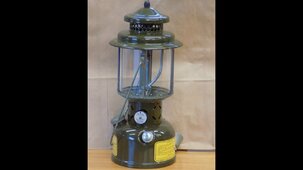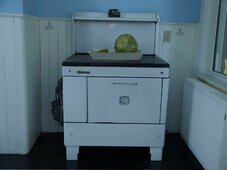I'm off topic and really want to apologize for this but I want to add some more about pressure lanterns white gas and low compression engines.
I'm sure everyone here has heard of lead in gasoline.
Back way back in the past gasoline was very hit and miss stuff.
it was not refined to a very tight tolerance and could not reliably be expected to run in engines that had higher than 4 or 5 to one compression.
TEL and MTEL compounds were added to lower octane fuel to run at higher pressure and temperature.
The reason is compression before ignition allows you to extract more energy from the combustion.
The mix is expanded more on the power stroke to extract energy from heat.
These lead compounds however leave deposits when they burn.
In pressure lanterns these clog the vaporizer, but they also release toxic lead into the air or food you are cooking on the device ( white gas stove )
There are some lanterns that were designed to burn leaded gas and have special gas generators to hold the lead in a filter inside ( these clog ).
White gas does not cogs and gum things up as fast as leaded gas.... ( clear unleaded gas as apposed to red coloured leaded fuel.. a dye was added to the fuel to identify it as leaded ).
But it still is not very clean stuff and is prone to all the normal problems of gasoline going bad..
Coleman fuel is highly refined fuel designed to prevent gumming and it has rust inhibitors added to protect your lantern.
Today all gasoline is white gas...
But its refined to a higher level to avoid the gum and stability problems of older 1960s white gas
Be wary of ethanol this does not make gas bad, it just makes it absorb water and this causes corrosion.
So it is technically safe to use in just about any lantern, but Coleman began to coat the inside of their lanterns and stoves with paints to prevent corrosion that might soften and peel if exposed to some of the aromatics in today's gasoline. ( Benzene Xylene, aromatics that are added to increase octane but these are solvents that will soften paints )
If you have an old lantern or stove with no coatings no problems use pump gas as long as it is not leaded ( and not aviation gasoline thats still leaded )
This is a typical leaded gas lantern about the most common you will find, made for military use it has a special gas generator to catch and hold lead but it will work just fine on unleaded gas.
There are others but this is most common you will find and these are not particularly good lanterns so I would not bother buying one, thats why they are so cheap in surplus...

last thing I want to show you is a Onan LK205.
This thing was designed in the days before gasoline was reliably consistent in quality.
It can burn fuel as low as 80 octane and the design was never optomized over its production run to burn higher octane leaded fuel
A few reasons for that...
Low compression wastes a lot of the heat energy in the gasoline, but its also less stress on the parts.
These units were intended to be very reliable and very long lasting, difficult to overload and most important able to use any gasoline type or grade.
Until I would say the 70s or so it was still pretty easy to get white gas in drums and this had no road tax so it was cheap.
Many people would buy drums of white gas for use off grid for cottages to light lanterns and run generators like the LK.
Some people went even further to use Kerosene and not only light but heat and cook on one standard fuel...
Now this is not cost effective, but at one time it was....
LK205.
2500 watt
1800 rpm
About 175 pounds
25 cubic inches in displacement, this is a very different kid of machine that you think of today when you say generator.
But its not unique.
Most flat heads made in this era were similarly low compression or could be modified to fairly easily burn 80 octane or lower fuels.
More added...
Most people who live or camp off grid these days think of wood stoves as their main cooking and heating source but this was not always the case in the past.
I have a stove like this at my family cottage, it was designed to burn kerosene.
Today you would be hard pressed to find one that still does since like mine most have been converted to use wood.

I won't waste time with wick lanterns and heaters, but there are wick fridges...
I'm not aware of gasoline off grid fridges and I would be very suspect of anyone selling one or would I ever even try and use one on that fuel.
This is a gasoline heater.
These were pretty common at one time a long with Kerosene versions.

That's all I have to say on the subject





